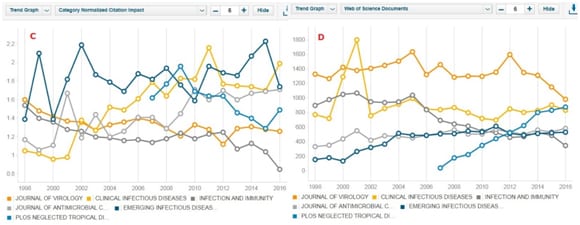Although Journal Impact Factor is perhaps the best-known metric provided by Clarivate Analytics, it is only one of several available indicators for assessing journal performance and influence. Here, I use the benchmarking tool InCites, built on the Web of Science foundation, to highlight other indicators that may be of interest to users.
To examine journal performance, I selected six of the top journals from two Web of Science categories: Infectious Diseases, and Virology.
• Journal of Virology
• Clinical Infectious Diseases
• Infection and Immunity
• Journal of Antimicrobial Chemotherapy
• Emerging Infectious Diseases
• PLOS Neglected Tropical Diseases
Below, Graph A shows the Journal Impact Factor trend for these selected titles.

In Graph A, Clinical Infectious Diseases is the top among the selected six, while second is Emerging Infectious Diseases, and the sixth is a new journal, PLOS Neglected Tropical Diseases, which began publication in 2007. Journal Impact Factor is calculated once a year, based on citations tallied through the previous year, so the score is not affected by the current year’s daily citation activities as recorded in the Web of Science. At this writing, the current Journal Impact Factor year is 2016, so citations for the most-recent full year, 2017, have not yet been taken into account – although they will of course be integral to the updated Journal Impact Factor scores, to be released in June 2018.
Graph B shows a trend graph with Times Cited calculated over a series of overlapping five-year windows from 1998 through 2016. By this measure, the Journal of Virology is clearly the most-cited of the selected publications, while Clinical Infectious Diseases rose to the #2 spot, having occupied third place for the period 1998 to 2002.

Above, Graph C indicates the Category Normalized Citation Impact (CNCI) score, which was developed for InCites but does not appear as part of Journal Citation Reports. CNCI is a telling statistic, since it is not affected by the size of the journal but will calculate the accumulation of each individual article while normalizing for different fields and publication years. As the graph shows, the #1 journal within the six is Emerging Infectious Diseases. Also, according to the CNCI measure, Clinical Infectious Diseases has seen its influence steadily increase.
Graph D conveys a very simple statistic, showing how many articles were indexed from the selected journals from 1998 to 2016. The graph, for example, shows that Clinical Infectious Diseases, aside from an apparent spike in the early 2000s, has largely maintained a consistent output. Meanwhile, the rapid progress of the comparatively new journal PLOS Neglected Tropical Diseases, from its founding in 2007, is also evident.
Researchers, administrators, publishers, and others are perennially interested in gauging journal impact. As we’ve seen, Journal Impact Factor is not the only useful Clarivate Analytics source for this purpose. Between Journal Citation Reports and InCites, there are now several metrics by which to assess journal performance.





